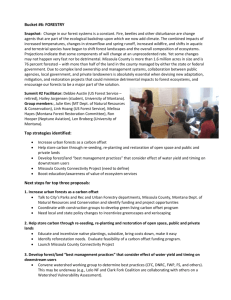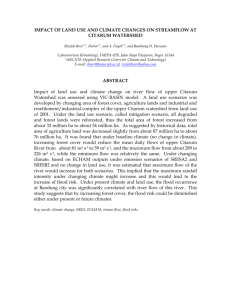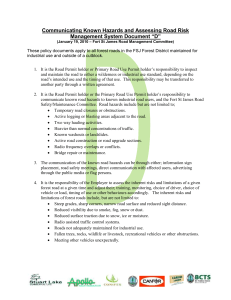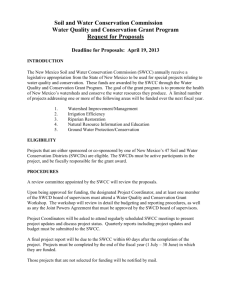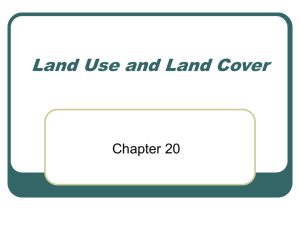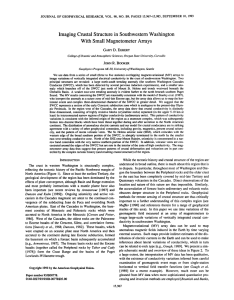the_wilderness_society_2013_great_northern_lcc_grant_proposal
advertisement
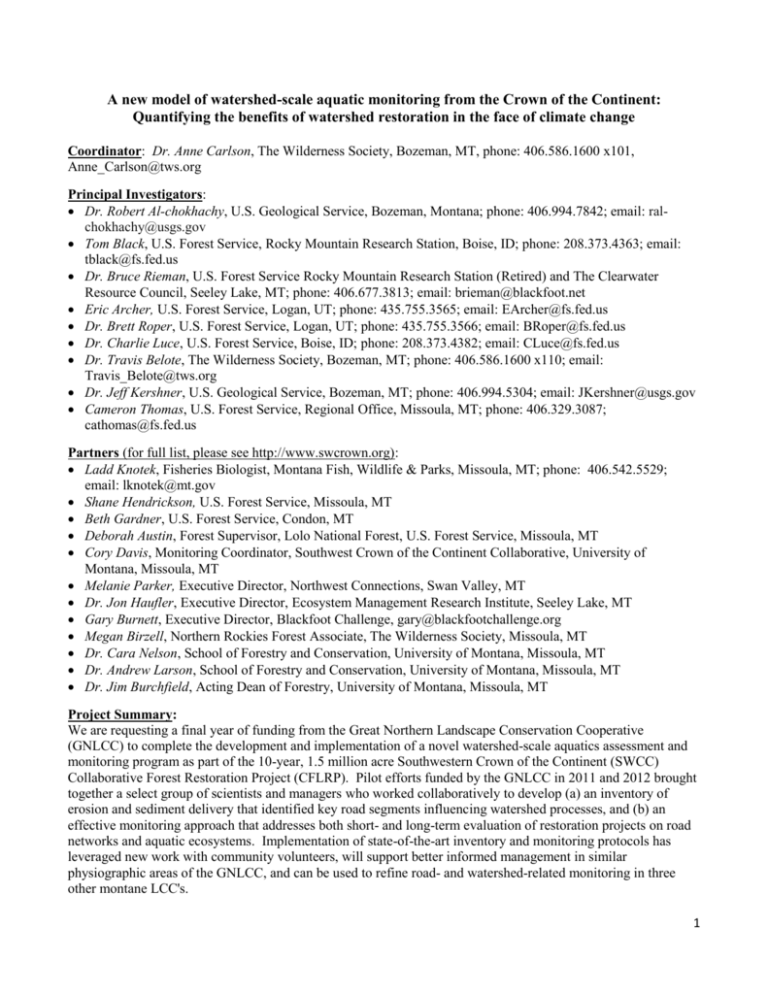
A new model of watershed-scale aquatic monitoring from the Crown of the Continent: Quantifying the benefits of watershed restoration in the face of climate change Coordinator: Dr. Anne Carlson, The Wilderness Society, Bozeman, MT, phone: 406.586.1600 x101, Anne_Carlson@tws.org Principal Investigators: Dr. Robert Al-chokhachy, U.S. Geological Service, Bozeman, Montana; phone: 406.994.7842; email: ralchokhachy@usgs.gov Tom Black, U.S. Forest Service, Rocky Mountain Research Station, Boise, ID; phone: 208.373.4363; email: tblack@fs.fed.us Dr. Bruce Rieman, U.S. Forest Service Rocky Mountain Research Station (Retired) and The Clearwater Resource Council, Seeley Lake, MT; phone: 406.677.3813; email: brieman@blackfoot.net Eric Archer, U.S. Forest Service, Logan, UT; phone: 435.755.3565; email: EArcher@fs.fed.us Dr. Brett Roper, U.S. Forest Service, Logan, UT; phone: 435.755.3566; email: BRoper@fs.fed.us Dr. Charlie Luce, U.S. Forest Service, Boise, ID; phone: 208.373.4382; email: CLuce@fs.fed.us Dr. Travis Belote, The Wilderness Society, Bozeman, MT; phone: 406.586.1600 x110; email: Travis_Belote@tws.org Dr. Jeff Kershner, U.S. Geological Service, Bozeman, MT; phone: 406.994.5304; email: JKershner@usgs.gov Cameron Thomas, U.S. Forest Service, Regional Office, Missoula, MT; phone: 406.329.3087; cathomas@fs.fed.us Partners (for full list, please see http://www.swcrown.org): Ladd Knotek, Fisheries Biologist, Montana Fish, Wildlife & Parks, Missoula, MT; phone: 406.542.5529; email: lknotek@mt.gov Shane Hendrickson, U.S. Forest Service, Missoula, MT Beth Gardner, U.S. Forest Service, Condon, MT Deborah Austin, Forest Supervisor, Lolo National Forest, U.S. Forest Service, Missoula, MT Cory Davis, Monitoring Coordinator, Southwest Crown of the Continent Collaborative, University of Montana, Missoula, MT Melanie Parker, Executive Director, Northwest Connections, Swan Valley, MT Dr. Jon Haufler, Executive Director, Ecosystem Management Research Institute, Seeley Lake, MT Gary Burnett, Executive Director, Blackfoot Challenge, gary@blackfootchallenge.org Megan Birzell, Northern Rockies Forest Associate, The Wilderness Society, Missoula, MT Dr. Cara Nelson, School of Forestry and Conservation, University of Montana, Missoula, MT Dr. Andrew Larson, School of Forestry and Conservation, University of Montana, Missoula, MT Dr. Jim Burchfield, Acting Dean of Forestry, University of Montana, Missoula, MT Project Summary: We are requesting a final year of funding from the Great Northern Landscape Conservation Cooperative (GNLCC) to complete the development and implementation of a novel watershed-scale aquatics assessment and monitoring program as part of the 10-year, 1.5 million acre Southwestern Crown of the Continent (SWCC) Collaborative Forest Restoration Project (CFLRP). Pilot efforts funded by the GNLCC in 2011 and 2012 brought together a select group of scientists and managers who worked collaboratively to develop (a) an inventory of erosion and sediment delivery that identified key road segments influencing watershed processes, and (b) an effective monitoring approach that addresses both short- and long-term evaluation of restoration projects on road networks and aquatic ecosystems. Implementation of state-of-the-art inventory and monitoring protocols has leveraged new work with community volunteers, will support better informed management in similar physiographic areas of the GNLCC, and can be used to refine road- and watershed-related monitoring in three other montane LCC's. 1 Need for project: In August of 2010, Congress established ten, decade-long CFLR projects to carry out fuel-reduction and ecological restoration treatments on public lands across the nation under a new model of community forestry. The SWCC collaborative in Montana was one of the initial projects and has identified ecological restoration needs across 1.5 million acres of the SWCC encompassing the Blackfoot, Clearwater, and Swan River Valleys in the Helena, Lolo, and Flathead National Forests, respectively. A primary objective of CFLR is to "maintain or improve water quality and watershed function" (FLRA 2009) by mitigating the effects of roads, and proposed restoration by the SWCC includes removal or mitigation of approximately 1,000 miles of roads and 150 streamcrossing structures (for full description of restoration work and socio-economic benefits to local communities within the SWCC landscape, please see www.swcrown.org). To facilitate short- and long-term evaluation of the effectiveness of restoration treatments and to inform future management strategies and actions on a landscape scale, the Forest Service (FS) has directed all CFLR projects to develop and implement a large-landscape monitoring program in association with each of these projects. Monitoring the effects of road systems on watersheds and fish populations presents significant challenges due to natural variability in landscape physiographic conditions and processes and complications associated with measurement error (e.g. Al-Chokhachy et al., 2010). The high costs of data collection coupled with limited funding for CFLR projects complicate the effort further. Roads are believed to have an important influence on watershed and ecological processes throughout the montane West, but their impacts on stream habitats and species remain controversial. The SWCC is no exception. Often relationships are assumed from general empirical models (e.g., Lee et al., 1997) that some argue are not relevant within the glaciated, belt geologies of the SWCC. Work to address these challenges and develop an appropriate monitoring program in the SWCC landscape was initiated through 2011 funding provided by CFLR and with 2011 and 2012 GNLCC grants, while salary, time, and other resources were contributed by the Forest Service Aquatic Monitoring Program, Forest Service Rocky Mountain Research Station, USGS Northern Rockies laboratory, Clearwater Resource Council and The Wilderness Society. Funding from GNLCC grants has allowed us to explore and refine methods to consider the effectiveness of roadrelated restoration from two perspectives. First, we are quantifying the broad relationships between roads and channel conditions in the SWCC using an established and widely vetted stream monitoring approach known as PIBO (Pacfish Infish Biological Opinion Effectiveness in the U.S. Forest Service Monitoring Program). Second, we are measuring road erosion processes directly using a similarly well-established U.S. Forest Service inventory and monitoring protocol known as GRAIP (Geomorphic Road Analysis and Inventory Package). In January of 2012, we held the first of three workshops for this project and proposed a new approach for the integrated application of these tools across the SWCC. At the second workshop in April of 2012, we refined sampling protocols, experimental design, and coordinated logistics for data collection and implementation of GRAIP and PIBO at the first two (of four) planned test sites in the SWCC that summer; data generated from 8 erosion plots installed in the summer of 2011 were key to calibrating the road erosion models used by GRAIP. In January of 2013, we held a third workshop to coordinate logistics for the final two (of four total) planned test sites in the SWCC this coming summer, and reviewed datasets and analyses generated during the 2012 field season from PIBO and GRAIP portions of the project (and from the erosion plots); we also spent time working to integrate the efforts of both perspectives using these early results, and created a plan of work for the writing and dissemination of numerous reports and scientific publications. Work to incorporate a climate change filter into these efforts has also continued over the course of the past year with the completion of analyses and formal testing of Variable Infiltration Capacity models for the SWCC (Leppi, in prep.). Here, we request funding to address four objectives in the final phase of implementation and testing of the integrated model of road effects for aquatic ecosystem assessment and monitoring. The objectives are to: 1) refine statistically-defensible monitoring protocols and test conceptual models linking road networks to current 2 stream and watershed conditions; 2) define the final protocols to monitor the effects of road-related restoration projects at both site and watershed scales; 3) engage a new partner, Montana Fish, Wildlife & Parks, to test a more rapid, less expensive application of the GRAIP tool - called GRAIP Lite – to guide watershed-scale restoration and water quality improvement, and (4) communicate relevant science information widely. This work will facilitate watershed management across the region through better understanding of watershed and ecosystem processes, and more effective prioritization of the limited management and restoration resources influencing species like westslope cutthroat trout and bull trout. This is particularly important given recognition of a rapidly changing climate (e.g. Pederson et al., 2010) and a growing focus on the need for vulnerability analysis to guide adaptation and transition strategies (Rieman and Isaak 2010; Rieman et al., 2007). By linking our work to identify critical sites that influence watershed processes with new tools to characterize population vulnerabilities (e.g. Peterson et al., in press), it should be possible to focus restoration far more effectively. The project helps leverage additional community-based monitoring concerned with the influence of roads on nutrient loading to lowland lakes as well. This ongoing project directly addresses three of the GNLCC’s stated conservation goals (“maintain large, intact landscapes of naturally functioning terrestrial and aquatic community assemblages”, “conserve a permeable landscape with connectivity across terrestrial and aquatic ecosystems”; and “maintain hydrologic regimes that support native or desirable plant and animal communities in still and moving water systems”) and all five of the GNLCC goals (“support science development, effect coordination, inform conservation action, monitor and evaluate, and communicate and educate”). Additionally, this work is relevant to many of the conservation targets across all three of the GNLCC ecotypic areas, including: (for the Columbia River Basin) riverine, riparian areas, and watershed uplands (ecosystems), aquatic connectivity (ecosystem process), and salmon, steelhead trout, and bull trout (species); (for the Rocky Mountain area) river and riparian areas (ecosystems), connectivity (ecosystem process), and cutthroat trout and bull trout (species); and (for the Sagebrush Steppe) riparian areas (ecosystems), connectivity (ecosystem process), and cutthroat trout (species). Finally, the proposed work complies with climate change directives for public lands managers from both the U.S. Forest Service and the Western Governors' Association (U.S.D.A. Forest Service, 2010; Western Governors' Association, 2010), is broadly applicable across the GNLCC region, and should be readily adaptable to three additional LCC's in mountain settings (the Southern Rockies LCC, the Great Basin LCC, and the North Pacific LCC). Overarching Objectives: This proposal endeavors to significantly increase our understanding of the effects of a priority landscape stressor roads – and watershed processes relevant to multiple GNLCC conservation targets in sub-regions of the GNLCC by supporting science development and coordination between two federal agencies, one state agency, and multiple NGOs across four LCC's. Our work will inform one of the most common, but ineffectively evaluated, conservation actions at the ecosystem level across the Western United State: the management of roads. Our approach is to refine existing landscape-scale indicators and monitoring tools to test assumptions about the effects of roads at the watershed-scale and provide the foundation to evaluate management actions in an adaptive management framework. After reviewing a variety of methods to address the first two objectives (above), the SWCC Monitoring Committee chose to refine and integrate two established approaches used widely in the region. We will complete implementation and testing of this new model in 2014. Objective #1: Pilot and adapt the Geomorphic Road Analysis and Inventory Package (GRAIP; http://www.fs.fed.us/GRAIP/index.shtml) for quantifying the erosion and delivery of sediment to streams and for monitoring of effects of road-related restoration projects at both site- and watershed-scales. GRAIP is designed to capture the range of road related risks to the aquatic system and to aid managers in prioritizing critical road restoration targets. It is a package of intensive sampling protocols (Black et al., 2012) and models (Cissel et al., 2012) that parameterizes and evaluates the production and delivery of fine sediment from forest roads. The process also identifies areas at high risk to shallow landslides, and gully initiation and stream crossings at high risk of failure and flow diversion. Although GRAIP is intended to be used with an intensive sampling effort, it 3 might be adapted to more extensive applications across the SWCC and other mountain landscapes with an appropriate validation and sampling scheme. Objective #2: Implement the refined U.S. Forest Service Pacfish Infish Biological Opinion Effectiveness Monitoring Program (PIBO; http://www.fs.fed.us/biology/fishecology/emp/) to quantify the influence of roads and road restoration on in-channel conditions and water quality in four complete watersheds across the SWCC project area. PIBO was designed to consider in-channel responses to watershed management actions across the Interior Columbia River Basin. Sampling has been intensified here to quantify variability within and among watersheds of the SWCC and the belt series geology in general. Results will test underlying conceptual models of road effects and guide design of future sampling in similar landscapes. The work proposed here will complete the analyses conducted under the existing two GNLCC grants. Objective #3: Test GRAIP Lite in the Deer Creek and neighboring sub-watersheds in collaboration with a new partner agency, Montana Fish, Wildlife & Parks (MFWP). The intent is to help MFWP rapidly identify the most important road segments for more detailed assessment, leading to eventual restoration. The spatially aggregated GRAIP Lite results will be validated against the spatially explicit GRAIP inventory results gathered in four nearby SWCC sub-watersheds. By working across land ownership the project will begin to export tools and methodology developed on federal lands to the entire landscape. If the process is successful it will support more general application and collaboration across landowners and managers in the SWCC, LCC and other similar landscapes. Objective #4: Communicate relevant science information widely. Specifically, we will share sampling methods, analytical models, protocols, results, and associated budgets for implementation of each tool, along with raw data, data summaries and analyses, technical reports, and scientific publications with regional and national partners across the GNLCC, and by focusing on three additional LCC’s where this work has particular relevance. Methods: Objective #1: The SWCC will implement GRAIP protocols within a variety of the climate, geologic and geomorphic settings found within the Southwest Crown. Information from an intensive hydro-geomorphic road inventory will be paired with surface erosion plot studies to validate model assumptions and to model sediment movement from roads at the watershed scale. Results from this work will be used to describe the stratification and sampling intensity needed to effectively evaluate road management effects across the broader SWCC and will help determine key mechanisms affecting watershed function. Objective #2: Implement the refined PIBO protocols to quantify the influence of roads and road restoration on inchannel conditions and water quality in four complete watersheds across the SWCC project area. We have adapted the methodology to provide adequate temporal and spatial replication to quantify the influence of roads on channel and ecological conditions within the SWCC project area. Metrics include substrate composition, pool formation, woody debris, macro-invertebrates, and other established PIBO metrics deemed useful in the workshops. The four focal watersheds (6th code Hydrologic Unit Code) have been selected for intensive monitoring based on anticipated restoration, existing potential road effects, and representation of the broader SW Crown. By the end of this coming field season, one watershed will have been sampled in each of the following basins: the Clearwater, Upper Blackfoot, Middle Blackfoot, and Swan. Within each watershed 20 sites will have been sampled in a stratified random manner to represent all potential response reaches and a range of management effects. The project will provide a foundation for long-term monitoring of the watershed process by managers in each basin and could extend indefinitely. Objective #3: Test GRAIP Lite, an analysis tool that trades time and expense for spatial resolution, in the Deer Creek and neighboring sub-watersheds in collaboration with a new partner agency, Montana Fish, Wildlife & Parks (MFWP). The Deer Creek sub-watershed has approximately 167 km of roads shown in the road system database with approximately 81 km located within 200 m of streams and 31 km located within 75 m. In the 4 absence of high resolution inventory information about the road system and how it interacts with the channel network, it is difficult to prioritize which of these roads are most likely to impact the aquatic system. We propose to carry out targeted road sampling in the Deer Creek watershed to calibrate a simple GIS model that will help identify the roads most likely to deliver sediment to the channel. This locally calibrated model will use road length, road slope, road vegetation, road maintenance category, and stream proximity to prioritize roads based on the probability of sediment delivery. This data will not only help refine areas for road restoration in Deer Creek it will also provide calibration for ongoing GRAIP-Lite modeling for physiographically similar portions of the SWCC and inter-montane west. Objective #4: Communicate relevant science information widely. The protocols, associated budgets, data, data summaries, data analyses, and final models and results will be shared widely with agency, academic, university, and NGO staff throughout the region and nationally via in-person presentations and meetings, webinars, factsheets, the GNLCC Data Portal, the SWCC website (www.swcrown.org) , technical reports, and scientific publications. Target audiences include colleagues within the GNLCC, the Crown Managers Partnership, the Crown of the Continent Conservation Initiative, members of the Confederated Salish and Kootenai Tribes, the Crown Round Table, other CFLR projects, and at regional and national scientific and agency meetings. Deliverables and Timeline: Calibration coefficients and base erosion rates for road erosion models specific to the SWCC (Dec 2013). Quantification of relationships between road metrics, modeled road sediment delivery, and in-channel conditions in four watersheds (Dec 2014) Summary report and GIS layers of hydro-geomorphic impacts of roads before restoration in two watersheds sampled during the summer of 2012 (Dec. 2013). Summary of and GIS layers of hydro-geomorphic impacts of roads before restoration in two watersheds sampled during the summer of 2013 (Dec. 2014). Independent variables representing the erosion and delivery of sediment to the watershed for analysis of channel response under objective #2 focused on quantification of relationships between roads and inchannel conditions (Dec. 2013) Protocol sharing within the GNLCC. Statistically-defensible, demonstration-site tested protocols for use in monitoring streams and watersheds across the Crown of the Continent pre- and post-restoration treatments (Dec. 2013) Data sharing within the GNLCC. Data and data summaries will be made available to agency, university, and conservation organization staff within the SWCC as well as the general public via the SWCC website (www.swown.org) and annual report (Nov. 2013 for field work completed in 2012; Nov. 2014 for field work completed in 2013) Detailed summary report that outlines findings within the region and each watershed to share with communities, local agencies, and critical organizations to prioritize research, restoration, and mitigation efforts; final report to the GNLCC (Dec. 2014) Summary of habitat conditions in four watersheds providing a baseline for long term monitoring of restoration effects; quantification of relationships between roads and in-channel conditions resolving the relationship of roads and habitat and the anticipated benefits of any restoration (Dec. 2014). Multiple peer-reviewed publications of the studies (2014-2015) Statement of Compliance: Anne Carlson, Project Coordinator for this proposal, and all nine Principal Investigators (see title page, above) have read the Great Northern Landscape Conservation Cooperative Information Management Delivery and Sharing Standards and agree to comply with those standards if this proposal is selected for funding. 5 APPENDIX I: Literature Cited Al-Chokhachy, R., Roper, B.B., and Archer, E.K. 2010. Evaluating the status and trends of physical stream habitat in headwater streams within the Interior Columbia River and Upper Missouri River basins using an index approach. Transactions of the American Fisheries Society 139: 1041-1059. Al-Chokhachy, R., and Roper, B.B. 2010. Different approaches to habitat surveys can impact fisheries management and conservation decisions. Fisheries 35(10): 476-488. Black, T.A., Cissel, R.M., Luce, C.H. 2012. The geomorphic road analysis and inventory package (GRAIP) Volume 1: Data collection method. Gen. Tech. Rep. RMRS-GTR-280WWW. Fort Collins, CO: U.S. Department of Agriculture, Forest Service, Rocky Mountain Research Station. 110 p. Cissel, R.M., Black T.A., Schreuders, K.A.T., Prasad, A., Luce, C.H., Tarboton, D.G., and Nelson, N.A. 2012. The geomorphic road analysis and inventory package (GRAIP) Volume 2: Office procedures. Gen. Tech. Rep. RMRS-GTR-281WWW. Fort Collins, CO: U.S. Department of Agriculture, Forest Service, Rocky Mountain Research Station. 160 p. Forest Landscape Restoration Act (FLRA). March 30, 2009. Pub. L. 111-11. Title IV. http://www.fs.fed.us/restoration/CFLR/documents/titleIV.pdf Lee, D., J. Sedell, B. Rieman, R. Thurow, and J. Williams. 1997. Assessment of the condition of aquatic ecosystems in the Interior Columbia River Basin. Chapter 4. Eastside Ecosystem Management Project. Pacific Northwest Research Station, PNW-GTR-405, Portland, OR. Pederson G.T., Graumlich L.J., Fagre D.B., Kipfer T., Muhlfeld C.C. (2010) A century of climate and ecosystem change in Western Montana: what do temperature trends portend? Climatic Change 98:133-154. Peterson, D.P., Wenger, S.J., Rieman, B.E., and Isaak, D.J. In press. Linking climate change and fish conservation efforts using spatially explicit decision support tools. Fisheries. http://www.fs.fed.us/psw/publications/reid/Reid_Furniss.html Rieman, B.E., and Isaak, D.J. 2010. Climate change, aquatic ecosystems, and fishes in the Rocky Mountain West: implications and alternatives for management. Gen. Tech. Rep. RMRS-GTR-250. Fort Collins, CO: U.S. Department of Agriculture, Forest Service, Rocky Mountain Research Station. http://www.fs.fed.us/rm/pubs/rmrs_gtr250.pdf. Rieman, B.E., Isaak, D.J., Adams, S., Horan, D., Nagel, D., and Luce, C. 2007. Anticipated climate warming effects on bull trout habitats and populations across the Interior Columbia River Basin. Transcatons of the American Fisheries Society 136: 1552-1565. U.S. Department of Agriculture Forest Service. July, 2010. National roadmap for responding to climate change. http://www.fs.fed.us/climatechange/pdf/roadmap.pdf Western Governors’ Association. 2010. Climate adaptation priorities for the Western states: scoping report. http://www.westgov.org/reports. 6 APPENDIX II: Map of sediment delivery points in one of two test site areas in the Seeley Lake Ranger District of the Southwestern Crown of the Continent Collaborative (SWCC). In 2012, co-PI’s on this grant used the analytic tool GRAIP to sample 110 miles of U.S. Forest Service roads in the Lolo National Forest on the Morrell Trail restoration project area, during which they recorded all sites of sediment delivery to nearby streams as well as the amount of sediment generated at each delivery point (GRAIP was calibrated using data from eight different sediment plots in the SWCC). The resulting map allows managers (and members of the public) to clearly identify relative sediment contributions from road areas within the project area. When analyzed alongside the modified PIBO datasets, these integrated data provide managers with extremely detailed information for use in making the most strategic use of Forest Service dollars across the landscape in an era of declining agency budgets. 7 3201 Spurgin Road Missoula, MT 59804 Phone 406-542-5506 E-mail: lknotek@mt.gov Fax: 406-542-5529 January 30, 2013 Clearwater Resource Council C/O Bruce Rieman P.O. Box 1471 Seeley Lake, MT 59868 RE: Application of GRAIP Analysis in Deer Creek Dear Bruce: As you know, Montana Fish, Wildlife and Parks (FWP) recently acquired ~ 25,000 acres in the former “Marshall Block” area northwest of Seeley Lake in creating the Marshall Creek Wildlife Management Area (WMA). Management and maintenance of the > 300 miles of non-system forest roads on the WMA is an ongoing challenge, but offers a significant opportunity for watershed-scale restoration and water quality improvement. The West Fork of the Clearwater River, upper Marshall Creek and Deer Creek are the major drainages on the WMA that support valuable native trout populations and high aquatic resource value. Thus far, the West Fork Clearwater River system has been the focus of watershed improvement activities, but this focus will likely shift to the Deer Creek basin over the next couple of years. Deer Creek is a direct tributary of Seeley Lake that lies primarily on FWP and U.S. Forest Service lands. This drainage has an extensive road network and a complex set of social and biological considerations that will be incorporated into restoration plans. Concurrent with acquisition and initial work on the WMA, the U.S. Forest Service and numerous partners have been cooperating on the Collaborative Forest Landscape Restoration (CFLR) Program in the southern portion of the “Crown of the Continent” region (encompasses most of the Clearwater Drainage). The CLFR includes projects and analysis tools that aid in identifying and prioritizing road segments that are problematic for watershed health. The Geomorphic Road Analysis and Inventory Package (GRAIP) is one of these tools that is extremely useful in road investigations. It is currently being applied in several Seeley Lake area drainages (e.g., Morrell/Trail Creeks, Cottonwood Creek) on federal lands. Our hope is to expand the application of the GRAIP analysis tool to other important tributary drainages within the Clearwater Basin and CFLR project area that may include non-Federal public lands – particularly Deer Creek. Deer Creek offers an exciting opportunity to prioritize and implement watershed improvement projects that would benefit bull trout, westslope cutthroat trout, and water quality in Seeley Lake. Application of GRAIP in Deer Creek would certainly complement our road inventory work and aid in our efforts to focus meaningful work there in the next several years. FWP would welcome the opportunity to be a partner in expanded road inventory and analysis applications in Deer Creek. Please let me know how I can assist in facilitating this effort. Sincerely, Ladd Knotek, Fisheries Biologist 8


